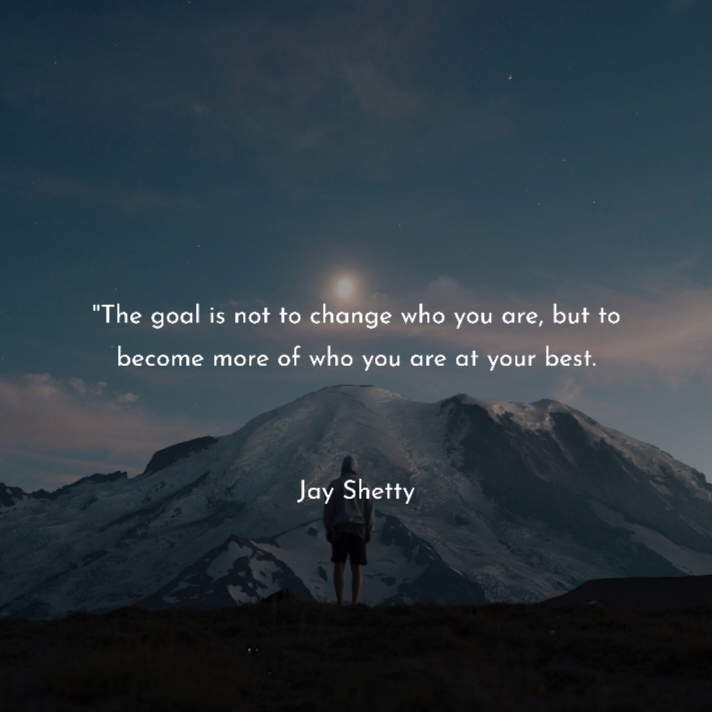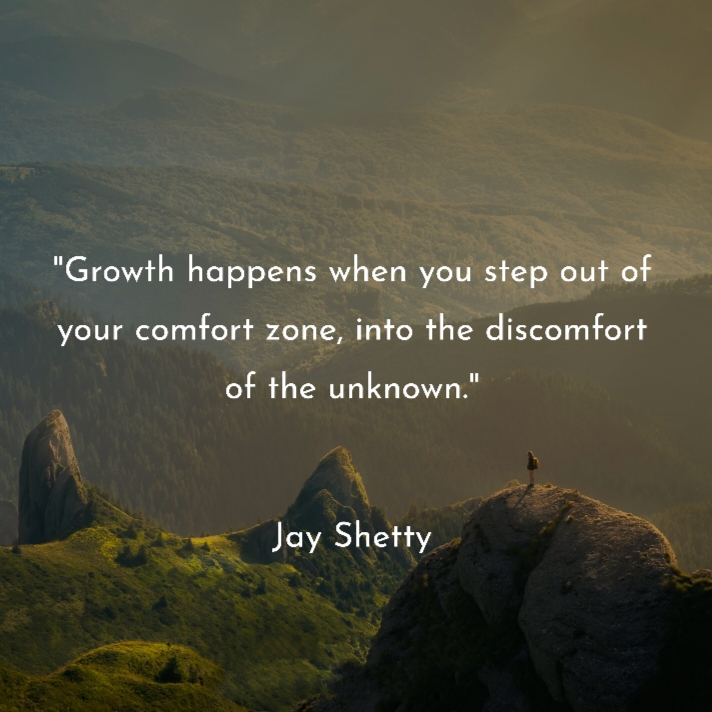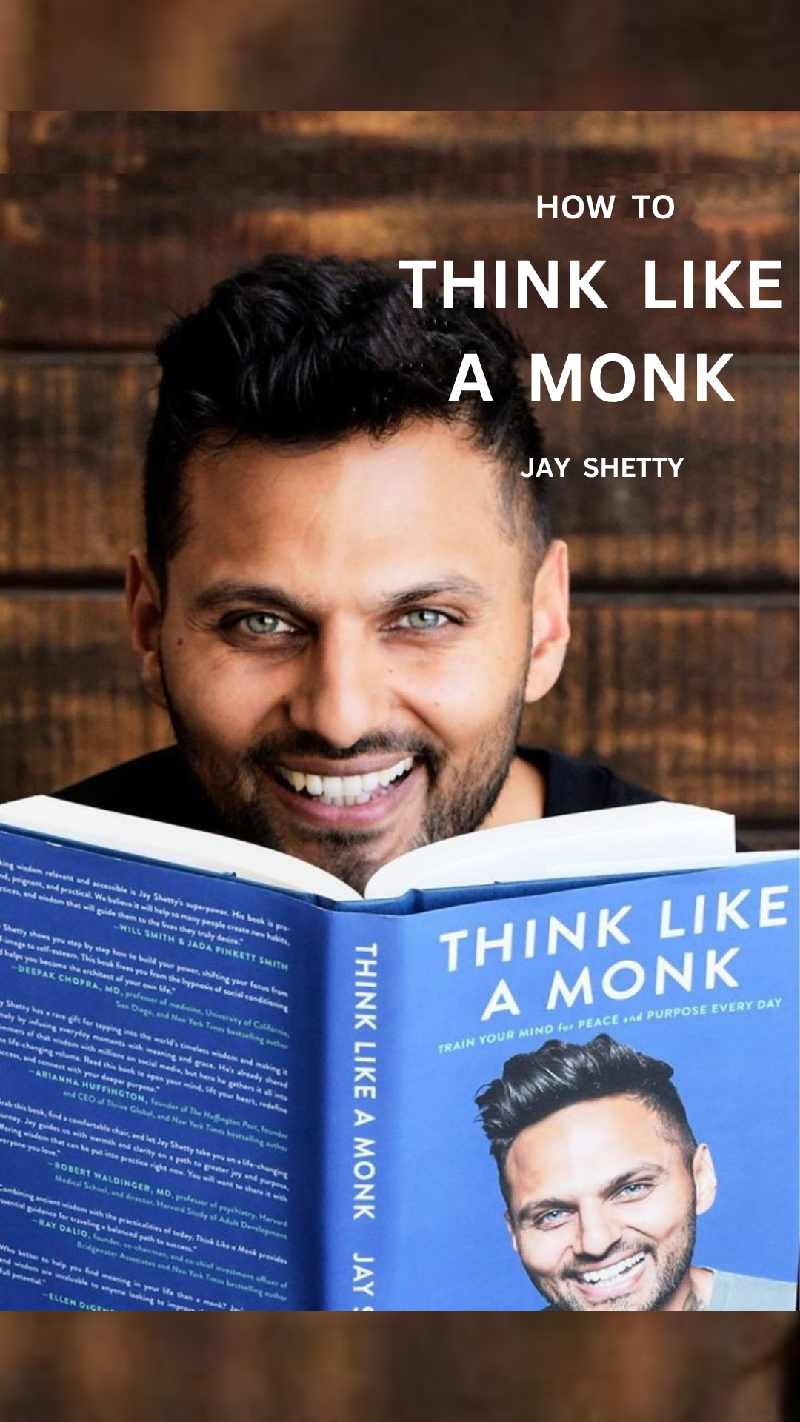“Your passion is for you, your purpose is for others. Your passion makes you happy. But when you use your passion to make a difference in someone else’s life, that’s a service, that’s a purpose, and that’s the hand.”
– Jay Shetty
Think Like a Monk is a self-help book by Jay Shetty, a former monk and social media superstar. The book draws on Shetty’s own experiences as a monk, as well as on ancient wisdom from different spiritual traditions, to offer practical advice on how to live a more mindful, peaceful, and purposeful life.
Think Like A Monk Summary begins by Jay Shetty explaining that the goal of the book is to help readers “think like a monk.” This doesn’t mean that you have to become a monk, but it does mean that you can adopt some of the same mental habits and practices that monks use to cultivate peace of mind and inner strength.
Think Like A Monk Summary – In Depth Analysis
INTRODUCTION
“If you want a new idea, read an old book”
– Ivan Pavlov
In the introduction of “Think Like a Monk” by Jay Shetty, the author sets the stage by sharing his personal journey of transformation from a college student with aspirations in a traditional career path to becoming a monk seeking deeper meaning and purpose. Jay introduces the concept of “monkey mind,” a state of constant mental chatter and distraction, and contrasts it with the focused and intentional mindset of a monk.
He outlines his intention to bridge the gap between ancient wisdom and modern challenges, offering practical advice for readers to cultivate a monk-like mindset that leads to inner peace and fulfillment. The introduction serves as a compelling invitation to explore the book’s teachings and embark on a journey of self-discovery and growth.

PART ONE – LET GO
1. IDENTITY – I Am What I Think I Am
“It is better to live your own destiny imperfectly then to live an imitation of somebody else’s life with perfection”
– Bhagvad Gita 3.35:
Alright, so in this chapter, Jay starts by sharing a bit about his own struggles. You know how we often get labeled by others and even by ourselves based on our roles and appearances, right? Well, Jay talks about how these labels can sometimes make us lose touch with who we really are. He suggests that we should look beyond these labels and dive into our true selves.
It’s like peeling off layers of expectations to find our inner essence. By letting go of these external identities, we can discover our own passions and dreams without being held back.

66 Powerful Quotes from Jay Shetty
2. NEGATIVITY – The Evil King Goes Hungry
It is impossible to build one’s own happiness on the unhappiness of others.
– Daisaku Ikeda
Now, Negativity is something we all face, right? Jay gets into how our minds can be like a constant generator of negative thoughts, making us doubt ourselves and feel down. But here’s the interesting part: he shows us that we can actually manage these negative thoughts. He shares cool techniques, like writing in a journal and focusing on gratitude, to flip the script on negativity.
It’s about recognizing those thoughts, changing them into positive ones, and creating a more positive outlook on life.
3. FEAR – Welcome To Hotel Earth
“Fear does not prevent death, it prevents life”
– Buddha
Fear, oh boy, that’s a big one. Jay talks about how fear can hold us back from taking chances and living the way we truly want. He tells us about his own experiences facing fear during his monk training. He categorises fear into different types, like the fear of what people might think or the fear of the unknown.
Jay encourages us to step outside our comfort zone, and he provides practical steps to confront and conquer these fears. It’s like taking small steps to show fear that it doesn’t control us.

4. INTENTION – Blinded by the Gold
“When there is harmony between the mind, heart, and resolution then nothing is impossible”
– Rig Veda
Now, intention is like the roadmap of our actions. Jay explains how setting a clear intention helps guide our choices and how we experience things. Think of it as the reason behind what you do. He introduces this cool term “Sankalpa,” which means a super meaningful intention that lines up with our values. It’s like setting a purpose for our actions that helps us stay true to ourselves.
Jay talks about how intentions even play a big role in relationships, reminding us to be present and genuine in our interactions.
MEDITATION – BREATHE
Alright, so imagine you’re stressed out or your mind is racing. Jay’s got this meditation technique that’s super easy to do. Find a comfortable spot to sit down, close your eyes, and take a deep breath in through your nose. Feel your lungs fill up with air, and then slowly exhale through your mouth. Do this a few times, just focusing on your breath. Inhale the good stuff, and let go of any tension as you exhale.
Now, as you breathe, try counting each breath. Inhale, count “1,” exhale, count “2,” and keep going up to “10.” If your mind starts to wander (which it probably will because, hey, that’s what minds do), just gently bring your focus back to counting your breaths. No need to get frustrated if thoughts pop up – it’s totally normal.
This simple practice helps you become more aware of the present moment, and it’s like a mini-vacation for your busy mind. Jay talks about how this practice can be a game-changer, helping you find a bit of calm in the midst of life’s chaos. And the cool thing is, you can do this pretty much anywhere – on your couch, in your car (when it’s parked, of course!), or even at your desk. It’s like a little reset button for your brain.
So, that’s the Breathe Meditation in a nutshell. It’s all about taking a few moments to focus on your breath and let go of stress. Give it a shot and see how it makes you feel!
PART TWO – “GROW”
5. PURPOSE – The Nature of the Scorpion
“When you protect your dharma, your dharma protects you.
-Manusmriti 8.15
Get ready for some purposeful introspection! Jay Shetty walks us through the idea of finding our life’s purpose. He explains how monks dedicate their lives to serving others and making a positive impact. But don’t worry, you don’t need a robe to do that! Jay helps us understand that purpose is about aligning our passions and skills with the needs of the world.
He guides us through exercises that help us explore our interests and talents, all while thinking about how we can contribute to the greater good. It’s like finding that special puzzle piece that fits perfectly into the big picture of life.

6. ROUTINE – Location Has Energy; Time Has Memory
“Every day think as you wake up, today i am fortunate to be alive, I have a precious human life, i am not going to waste it”
– the Dalai Lama
Routines might sound a tad boring, but Jay flips the script on that! He introduces us to the monk routine, which involves meditation, yoga, and studying ancient wisdom. And hey, you don’t need to wake up at sunrise if that’s not your thing! Jay breaks down how routines can actually be the superheroes of our day-to-day lives. They help us manage our time effectively, reduce stress, and maintain balance.
He even offers tips to create a personalized routine that suits our unique goals and preferences. It’s like building your own daily roadmap to success and well-being.
7. THE MIND – The Charioteer’s Dilemma
“When the five senses and the mind are stilled, when the reasoning intellect rests in silence, then begins the highest path”
– the Katha Upanishad
Let’s dive into the mind palace! Jay Shetty takes us on a journey through the power of our thoughts. He introduces this fancy term “Antakharana,” which is like the bridge between our thoughts and the way we experience the world. Jay explains how our thoughts can shape our emotions and behaviours.
He encourages us to cultivate a positive mindset by practicing things like gratitude and empathy. It’s like giving your mind a spa day to help it stay refreshed and focused on the good stuff.

8. EGO – Catch Me If You Can
They are forever free who renounce all selfish desire and break away from the ego cage of “I”, “Me” and “Mine”
– Bhagavad Gita, 2:71
Ah, the ego, that tricky little thing! Jay explores the concept of ego and how it can sometimes be like that loud friend who hogs the conversation. He shows us how the ego often leads to comparison and competition, keeping us from genuine connections. But fear not! Jay contrasts this with the monk’s practice of humility and service. He helps us understand when our ego is trying to take over and offers strategies to keep it in check.
It’s like learning to have a friendly chat with that ego, saying, “Hey, we’re in this together, so let’s keep things real.”
MEDITATION: Visualize
In this section of the book, Jay Shetty introduces a meditation visualization technique as a way to help readers tap into their inner potential and manifest their aspirations. He explains that visualization is like a mental rehearsal, where you create vivid images in your mind to bring your goals to life.
HOW TO PRACTICE
1. Find a Quiet Space:
Begin by finding a quiet and comfortable space where you won’t be disturbed.
2. Relax:
Sit or lie down in a relaxed position. Take a few deep breaths to center yourself.
3. Choose Your Goal:
Select a specific goal or intention that you want to visualize. It could be related to your career, relationships, health, or personal growth.
4. Visualize:
Close your eyes and start imagining the scenario associated with your goal. Picture it as vividly as possible. Use all your senses to make the visualization feel real.
5. Feel the Emotions:
As you visualize your goal, also feel the emotions that come with it – the happiness, excitement, and satisfaction.
6. Be Present:
Imagine yourself in the future, having achieved your goal. Feel the joy and contentment in that moment.
7. Repeat Regularly:
Practice this visualization technique regularly, ideally every day. The more you engage with the imagery, the more it becomes ingrained in your subconscious mind.
THE POWER OF VISUALIZATION
Jay emphasizes that visualization can have a powerful impact on your mindset and actions. By consistently visualizing your goals, you align your thoughts and emotions with the outcome you desire. This can lead to increased motivation, focus, and a positive attitude. Jay suggests that visualization is like planting a seed in your mind, which, with time and effort, can blossom into reality.
Embark on a literary Adventure with Us
PART 3 – SERVE
9. GRATITUDE – The Words Most Powerful Drug
Appreciate everything even the ordinary, Especially the ordinary.
-Pema chödrön
In this chapter, Jay Shetty explores the transformative power of gratitude. He emphasizes that gratitude is not just a fleeting emotion but a way of life. Jay explains how monks practice gratitude as a means to connect with the present moment and shift their focus from what’s lacking to what’s abundant. He introduces the concept of “Present Shock,” highlighting how gratitude anchors us in the now.
Jay provides practical exercises to cultivate gratitude, encouraging readers to create a gratitude journal and find blessings even in challenging situations.

10. RELATIONSHIPS – People Watching
Every person is a world to explore.
– Thich Nhat Hanh
Jay delves into the intricate dance of relationships in this chapter. He discusses the concept of “Sangha,” a community that supports one another’s growth. Jay emphasizes the importance of surrounding ourselves with positive influences and nurturing healthy relationships. He offers insights on communication, empathy, and active listening.
Jay also explores the idea of letting go of toxic relationships and setting boundaries. Through personal stories and anecdotes, he guides readers on creating meaningful connections that uplift and inspire.
11. SERVICE – Plant Trees Under Whose Shade You Do Not Plan To Sit
The ignorant work their own profit…
the wise work for the welfare of the world…
– Bhagvad Gita, 3.25
In the final chapter, Jay Shetty focuses on the practice of selfless service. He explains how monks dedicate their lives to serving others and highlights the joy that comes from giving without expecting anything in return. Jay introduces the concept of “Karma Yoga,” where actions are driven by service rather than personal gain. He discusses how serving others not only benefits them but also leads to our own growth and fulfillment.
Jay encourages readers to identify ways they can make a positive impact in their communities and the world at large.
MEDITATION – CHANT
Jay explains that meditation is a way to quiet the mind and connect with our inner selves. He suggests that even a few minutes of meditation daily can help us build focus and awareness. Chanting, on the other hand, involves the repetition of sounds or words, often in a rhythm. Jay introduces the “Om” chant, a sacred sound believed to connect us with the universe’s energy.
Benefits of Chanting:
Jay outlines the benefits of chanting, such as soothing the nervous system, reducing stress, and helping with relaxation. He explains that the vibrations created during chanting can have a positive impact on our well-being and mental state.
Chant as a Mantra:
Jay introduces the concept of using a personal mantra during meditation and chant. A mantra is a word or phrase that holds personal significance and helps us focus during the practice. He encourages readers to select a word or phrase that resonates with their goals and values.
Creating a Chanting Routine:
Jay suggests incorporating chanting into our daily routine, just like the monks do. He recommends starting the day with a few minutes of chant to set a positive tone for the day ahead. Chanting can also be a calming practice before bedtime, helping us wind down and prepare for restful sleep.
Overall, the section on meditation and chant emphasizes the benefits of these practices in promoting mindfulness, relaxation, and self-awareness. Jay Shetty guides readers on incorporating these practices into their daily lives to experience a greater sense of inner peace and connection.

66 Powerful Quotes From Jay Shetty
Think Like A Monk Review
So, “Think Like a Monk” by Jay Shetty, was quite the eye-opener! From the moment I cracked open the pages, I felt like Jay was right there, having a heart-to-heart chat about life, purpose, and mindfulness.
One thing that struck me right off the bat was how relatable Jay’s stories are. He doesn’t just talk about life in a monastery; he takes those lessons and effortlessly translates them into real-world situations. It’s like he’s saying, “Hey, monks might live in monasteries, but these lessons are for all of us.”
The idea of letting go, something Jay dives into in the first part of the book, hit close to home. Letting go of labels and expectations, who hasn’t struggled with that, right? Jay’s personal anecdotes and those of other people really drove home the point that we’re not alone in this journey.
As I moved into the second part, “Grow,” I found the chapters on routine and mindfulness super practical. Jay doesn’t just preach; he provides step-by-step guides on how to incorporate meditation and positive habits into our everyday lives. And let’s face it, sometimes we all need a nudge in that direction.
“Serve,” the third part, was a true gem. Jay talks about gratitude, relationships, and service in a way that genuinely made me pause and reflect. His insights on gratitude and its power to shift our perspectives really resonated. And the chapters on relationships and service? They made me rethink how I approach my interactions and contributions to the world around me.
About Jay Shetty
Jay Shetty is the author of “Think Like a Monk.” He is a British-Indian motivational speaker, author, and former monk. Shetty gained prominence through his inspirational content on social media, where he shares wisdom on personal development, mindfulness, and purposeful living. His book draws on his experiences as a monk to provide practical insights for living a more meaningful and fulfilling life. Jay Shetty’s work has resonated with millions of people worldwide, making him a prominent figure in the self-help and personal growth space.
FAQs
1. What is “Think Like a Monk” about?
– “Think Like a Monk” by Jay Shetty is a book that draws from the author’s experiences as a former monk to provide insights on personal growth, mindfulness, and finding purpose in life.
2. Can you give a brief book summary?
– Certainly! “Think Like a Monk” explores the journey to self-discovery, offers practical wisdom, and provides guidance on living a more meaningful and purposeful life.
3. What are some key takeaways from the book?
– Key takeaways include understanding the power of beliefs, finding your life’s purpose (dharma), developing daily routines for mindfulness, and cultivating gratitude.
4. Are there any notable quotes from the book?
– Yes, the book is filled with inspirational quotes. One example: “The time we spend in silence helps us make better choices.”
5. How does Jay Shetty’s background as a monk influence the book?
– Shetty’s experiences as a monk provide a unique perspective on mindfulness, self-discovery, and inner peace, which are central themes in the book.
6. Is this book suitable for all readers, regardless of their beliefs?
– Yes, the book is designed to be inclusive and offers universal principles for personal growth that can benefit readers from various backgrounds.
7. What does the book say about dealing with life’s challenges?
– The book provides insights on facing life’s challenges with resilience and offers strategies for maintaining a positive mindset.
8. How does “Think Like a Monk” approach the topic of relationships?
– Shetty explores building meaningful relationships based on appreciation rather than expectation, offering valuable insights for improving all kinds of relationships.
9. Does the book provide practical exercises or actionable advice?
– Yes, the book includes practical exercises and actionable advice to help readers apply its principles in their daily lives.
10. Can you share some of the author’s personal stories from the book?
– The book includes personal anecdotes from Jay Shetty’s time as a monk, which provide real-world examples of the principles he discusses.
11. Is there a particular chapter that stands out as especially impactful?
– Many readers find Chapter 6, which focuses on daily routines and rituals, particularly impactful for establishing a more disciplined and mindful life.
12. Does the book discuss the importance of gratitude?
– Yes, the book emphasizes the role of gratitude in personal growth and offers guidance on how to cultivate it.
13. How can readers apply the book’s teachings in their own lives?
– Readers can apply the book’s teachings by practicing mindfulness, discovering their life’s purpose, and incorporating daily rituals for personal growth.
14. What sets “Think Like a Monk” apart from other self-help books?
– The book’s unique perspective, rooted in Jay Shetty’s experiences as a monk, provides fresh insights and actionable advice for readers seeking personal growth.
15. Is “Think Like a Monk” recommended for those new to self-help literature?
– Yes, the book is accessible and suitable for readers new to self-help literature, as well as those looking to deepen their understanding of mindfulness and personal growth.
Happy reading!




Wow, incredible blog structure! How lengthy have
you ever been blogging for? you made running a
blog glance easy. The overall glance of your website is wonderful, let alone the content!
You can see similar: dobry sklep and
here ecommerce
Aw, this was an extremely good post. Taking the time and actual effort
to produce a really good article… but what can I say… I hesitate a whole lot and don’t manage
to get nearly anything done. I saw similar here:
ecommerce and also here: e-commerce
Your article helped me a lot, is there any more related content? Thanks!
It’s a pity you don’t have a donate button! I’d definitely donate to this
fantastic blog! I suppose for now i’ll settle for book-marking and
adding your RSS feed to my Google account.
I look forward to fresh updates and will share this blog
with my Facebook group. Talk soon! I saw similar here: Sklep internetowy
Hello! Do you know if they make any plugins to assist with SEO?
I’m trying to get my blog to rank for some targeted keywords but
I’m not seeing very good results. If you know of
any please share. Many thanks! You can read similar text here: Sklep internetowy
Hey there! Do you know if they make any plugins to assist with Search Engine Optimization? I’m trying to get my blog to rank for some targeted keywords
but I’m not seeing very good results. If you know of any please share.
Kudos! You can read similar article here: Sklep internetowy
Hi there! Do you know if they make any plugins to assist with SEO?
I’m trying to get my blog to rank for some targeted keywords but I’m not seeing very good results.
If you know of any please share. Cheers!
I saw similar art here: Auto Approve List
Wow, superb weblog structure! How lengthy have you been running a blog for?
you make running a blog look easy. The entire look of your website is excellent,
as well as the content material! You can see
similar here najlepszy sklep
Wow, wonderful blog layout!
How long have you been blogging for? you make blogging look easy.
The entire glance of your website is magnificent, let alone the
content material! I read similar here prev next and it’s was wrote by Madalene98.
Wow, fantastic blog layout!
How long have you been running a blog for?
you make running a blog glance easy. The entire glance of your
site is excellent, let alone the content! I read similar here prev next and those was wrote
by Santos81.
Wow, awesome weblog format!
How long have you been running a blog for?
you made blogging look easy. The entire look of your
website is wonderful, as well as the content! I saw similar here prev next and that
was wrote by Hyon73.
10 Top Mobile Apps For Porn Star British Porn Stars On Adultwork
Absolutely pent subject matter, appreciate it for selective information .대출
“Situs penghasil uang terbaik adalah pilihan yang tepat buat yang pengen dapet uang tambahan. Seru dan menguntungkan!”
Your passion for this topic shines through in your writing.급전
I’ve learned so much from reading your blog, thank you!대출
Your writing has a real impact on me.급전
I appreciate the time and effort you’ve put into this article.대출
This post resonated with me deeply. Thank you for sharing your insights.대출
Your insights have broadened my understanding.급전
I’m inspired by your passion for this subject.대출
I really appreciate the thorough analysis you’ve provided here.swiftnook
Your writing style is engaging and informative. Keep it up!rendingnicheblog
I found your perspective on this topic very interesting. Well done!blogpulse